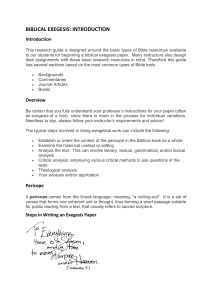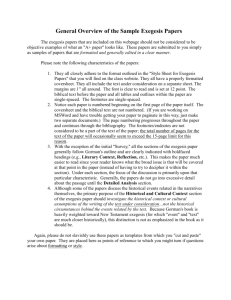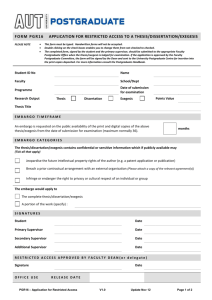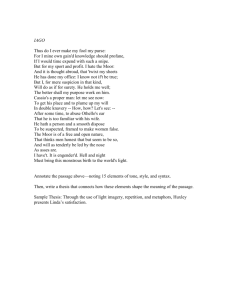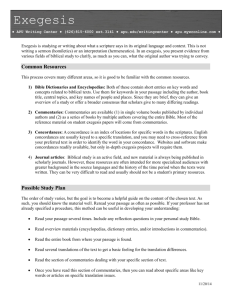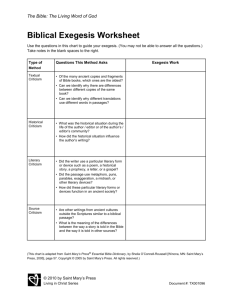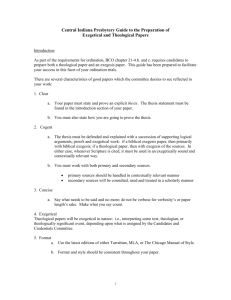How to Write an Exegesis Paper for the New
advertisement
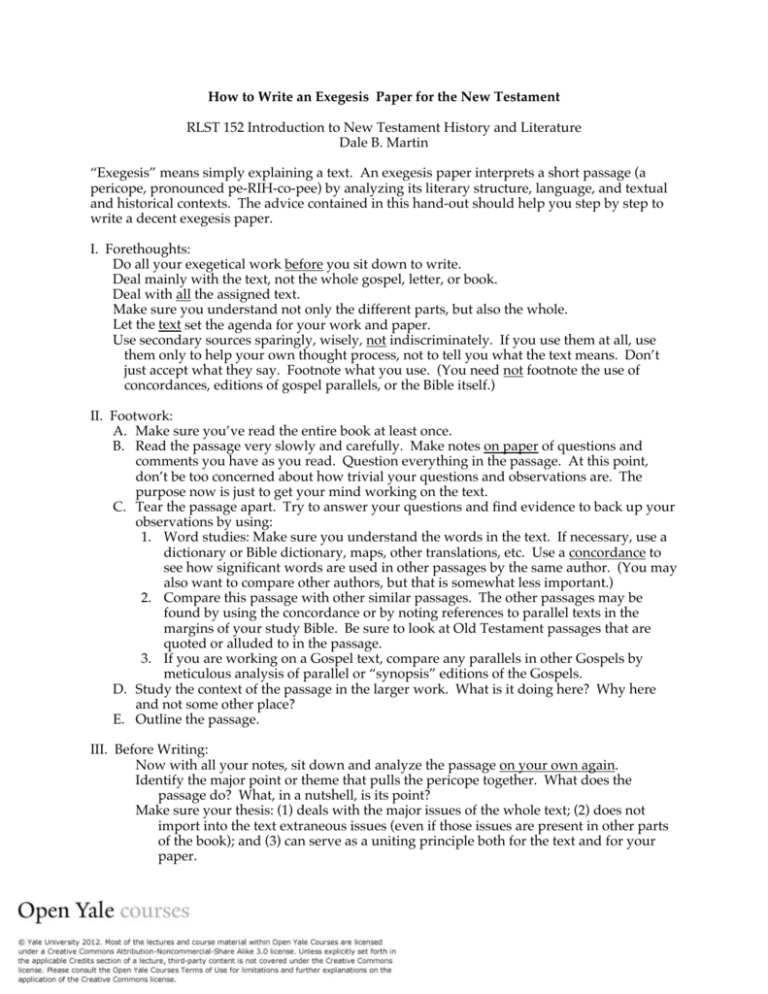
How to Write an Exegesis Paper for the New Testament RLST 152 Introduction to New Testament History and Literature Dale B. Martin “Exegesis” means simply explaining a text. An exegesis paper interprets a short passage (a pericope, pronounced pe-RIH-co-pee) by analyzing its literary structure, language, and textual and historical contexts. The advice contained in this hand-out should help you step by step to write a decent exegesis paper. I. Forethoughts: Do all your exegetical work before you sit down to write. Deal mainly with the text, not the whole gospel, letter, or book. Deal with all the assigned text. Make sure you understand not only the different parts, but also the whole. Let the text set the agenda for your work and paper. Use secondary sources sparingly, wisely, not indiscriminately. If you use them at all, use them only to help your own thought process, not to tell you what the text means. Don’t just accept what they say. Footnote what you use. (You need not footnote the use of concordances, editions of gospel parallels, or the Bible itself.) II. Footwork: A. Make sure you’ve read the entire book at least once. B. Read the passage very slowly and carefully. Make notes on paper of questions and comments you have as you read. Question everything in the passage. At this point, don’t be too concerned about how trivial your questions and observations are. The purpose now is just to get your mind working on the text. C. Tear the passage apart. Try to answer your questions and find evidence to back up your observations by using: 1. Word studies: Make sure you understand the words in the text. If necessary, use a dictionary or Bible dictionary, maps, other translations, etc. Use a concordance to see how significant words are used in other passages by the same author. (You may also want to compare other authors, but that is somewhat less important.) 2. Compare this passage with other similar passages. The other passages may be found by using the concordance or by noting references to parallel texts in the margins of your study Bible. Be sure to look at Old Testament passages that are quoted or alluded to in the passage. 3. If you are working on a Gospel text, compare any parallels in other Gospels by meticulous analysis of parallel or “synopsis” editions of the Gospels. D. Study the context of the passage in the larger work. What is it doing here? Why here and not some other place? E. Outline the passage. III. Before Writing: Now with all your notes, sit down and analyze the passage on your own again. Identify the major point or theme that pulls the pericope together. What does the passage do? What, in a nutshell, is its point? Make sure your thesis: (1) deals with the major issues of the whole text; (2) does not import into the text extraneous issues (even if those issues are present in other parts of the book); and (3) can serve as a uniting principle both for the text and for your paper. IV. Writing the Paper: Let your thesis furnish the outline for your paper and what will be included and excluded. Be clear at the beginning about your thesis! (You may decide after writing some that you want to modify your thesis somewhat. But you need the clarity of thought furnished by a clear articulation of your thesis.) This is not a commentary. Organize your paper around your thesis, not simply around a verse by verse comment on the text. You don’t have to deal in your paper with everything you find in the text. Use discretion about what to exclude. Remember: you have to prove your point. Don’t just tell me, show me. Imagine me sitting on your shoulder as a “devil’s advocate” calling your hand on your ideas and statements. Be specific, not general or wishy-washy. Convince me with textual evidence. Make your paper an explanatory or descriptive exegesis—not a sermon! Do not include unnecessary material. Don’t include everything you know or have found out. Include only what will support your main interpretation of the text. The writing of the paper is very important. Write in a clear, straightforward style with no jargon. Read your writing aloud to yourself to check your style. Let a friend or writing tutor also read and critique what you write. For suggestions about writing, you may look at some short guide to writing style, such as Bailey’s Writing Clearly, Strunk and White’s Elements of Style (a bit oldfashioned, I admit), or some such handbook. Lots of bookstores have lots of these things. Use them! Useful Books: An analytical concordance to the Revised Standard Version of the New Testament, ed. Clinton Morrison: several copies on different kinds of reserve and in reference rooms in CCL, SML, & Div Ref BS2305 +M67 (LC). Some edition of the New Testament in which several different translations are placed side by side. One is The Eight Translation New Testament in the Divinity School reference room: BS2025 1974 C48. But many others are available. The Interpreter’s Dictionary of the Bible. Note also that there is a “supplement” volume with more recent, updated articles. SML reference: BS440 I582 (LC), as well as CCL stack reference and Div School reference. There are lots of other Bible Dictionaries that are also good. The best thing is to snoop around in a few in a reference room and compare entries. Gospel Parallels, ed. Throckmorton. CCL stack reference: BS2560 T47 1967 (LC), as well as Div school, and other places around campus. Other parallels are also fine, such as Kurt Aland, ed., Synopsis of the Four Gospels. Or just look up that title on the computer, and you’ll find several editions. You should not need to consult other explanations of exegesis. But should you desire further reading on “how to do exegesis,” the following are possibilities: Hayes, J. and Holladay, C. Biblical Exegesis: A Beginner’s Handbook. Furnish, V. P., “Some Practical Guides for NT Exegesis,” Perkins School of Theology Journal 26 (1973): 1-16. Keck, L. and Tucker, G., “Exegesis,” in the Interpreter’s Dictionary of the Bible: Supplement (see above).
